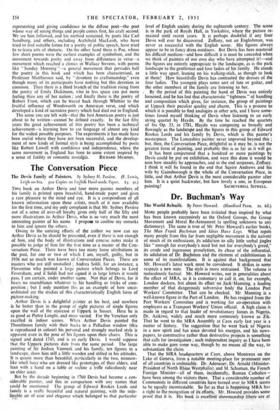The Conversation Piece
This book on Arthur Devis and four more painter members of . his family is printed upon beautiful, hand-made paper and gives a rare pleasure to the mind and eye. It is a compendium of all
known information upon these artists, much of it now available for the first time, and my only complaint is that Mr. Sydney Paviere out of a sense of over-all loyalty gives only half of the fifty and more illustrations to Arthur Devis, who is so very much the most interesting painter of his name. 1 propose to confine my remarks to him and ignore the others.
Owing to the untiring efforts of the author we now can sec Arthur Devis as he should be presented, even if there is not enough . of him, and the body of illustrations and concise notes make it possible to judge of him for the first time as a master of the Con- versation Piece. There have been too many loose attributions in the past, for one or two of which I am, myself, guilty, but in 1936 not so much was known of Conversation Pieces. There are masters who are still unstudied ; Andrea Soldi, for an instance, a Florentine who painted a large picture which belongs to Lord Feversham, and if Soldi had not signed it in large letters it would pass, I am certain, under another name. • Not that of Devis, for it bears no resemblance whatever to his handling or tricks of com- position ; but I only mention this as an example of how unco- ordinated are the studies of this characteristically English form of picture-making. Arthur Devis is a delightful painter at his best, and nowhere is he better tan in the group of eight pictures of single figures upon the wall of the staircase at Uppark in Sussex. Here he is as good as Pietro Longhi, and more varied. For the Venetian only excelled in indoor scenes. When Arthur Devis painted the Thomlinson family with their backs to a Palladian window (this is reproduced in colour) his personal and strongly marked style is apparent even in the pose of his figures upon their chairs. This is signed and dated 1745, and is an early Devis. I would suppose that the Uppark pictures date from the same period. The large painting of Sir Joshua Vanneck and his family, ten figures in a landscape, show him still a little wooden and stilted in his attitudes. It is quaint more than beautiful, particularly in the two, minnow- like small boys who are dressed like prototypes of their elders, and lean with a hand on a table or recline a trifle ridiculously near an elder sister.
But by the decade beginning in 1760 Devis had become a con- siderable painter, and this in comparison with any names that could be mentioned The group of Edward Rookes Leeds and family is a really beautiful and natural painting, with the inde- finable air of ease and elegance which belonged to that particular
(IT
level of English society during the eighteenth century. The scene is in the park of Royds Hall, in Yorkshire, where the picture re- mained until recent years. It is perhaps doubtful if any finer Devis will ever be discovered. Zoffany, not an Englishman, was never as successful with the English scene. His figures always appear to be in fancy dress outdoors. But Devis has here mastered his difficult medium—and how difficult it is must be conceded when we think of painters of our own day who have attempted it!—and the figures are entirely appropriate to the landscape, as is the park landscape to the gentleman and four ladies of his family. He stands a little way apart, leaning on his walking-stick, as though to look at them! How beautifully Devis has contrasted the dresses of the four ladies. The youngest plays some sort of lute or guitar, and the other members of the family are listening to her.
By the period of this painting the hand of Devis was entirely loosened, and he has lost that characteristic " tightness " of handling and composition which gives, for instance, the group of paintings at Uppark their peculiar quality and charm. This is a process to which it is possible to find analogies in other arts, and I have some- times found myself thinking of Devis when listening to an early string quartet by Haydn. By the time he reached the quartets of his Op. 33, in 1781, Haydn was composing as broadly and flowingly as the landscape and the figures in this group of Edward Rookes Leeds and his family by Devis, which is this painter's masterpiece. The Lancashire painter never improved beyond this ; but, then, the Conversation Piece, delightful as it may be, is not the greatest form of painting, and probably this is as far as it will go.
It has been conjectured that a hundred or more paintings by Devis could be put on exhibition, and were this done it would be seen how steadily he approaches, and in the end surpasses, Zoffany. I think it will be found in the end that Squire Andrews and his wife by Gainsborough is the whole of the Conversation Piece, in little, and that Arthur Devis is the most considerable painter after him. It is a quiet backwater, but how lovely a one, in European


































 Previous page
Previous page